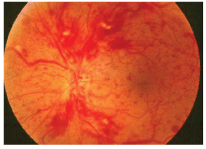 A 62-year-old female presents with sudden, painless loss of vision in her left eye. She is diagnosed with a non-ischemic central retinal vein occlusion (CRVO) O.S. The diagnosis is clear, but the management is not. Laser photocoagulation is not beneficial for patients with visual loss from macular edema caused by CRVO.1
A 62-year-old female presents with sudden, painless loss of vision in her left eye. She is diagnosed with a non-ischemic central retinal vein occlusion (CRVO) O.S. The diagnosis is clear, but the management is not. Laser photocoagulation is not beneficial for patients with visual loss from macular edema caused by CRVO.1
Traditionally, we have had to take a watch and wait approach to these patients. But, recent advances involving Avastin (bevacizumab, Genentech) offer hope to patients such as this one. However, there appears to be little consistency in the use of Avastin, and no randomized, controlled clinical trials yet direct its use in these conditions. Here, we review current research to see how it is being used clinically.
Neovascularization and Edema
CRVO, diabetic retinopathy and other ocular conditions can lead to retinal capillary closure and hypoxia. When this occurs, there is up-regulation of vascular endothelial growth factor (VEGF).2 VEGF stimulates angiogenesis, which promotes endothelial cell migration and proliferation. Also, it is associated with breakdown of the blood-retinal barrier, which results in increased vascular permeability and fluid leakage. These lead to the development of neovascularization and retinal edema.3
Avastin, a potent VEGF inhibitor, is a humanized monoclonal antibody that was initially developed to treat metastatic colorectal cancer.4 VEGF inhibitors block the up-regulation of VEGF, eliminating the stimulus for neovascularization and reducing the vascular permeability that causes retinal edema.
Retinal Vein Occlusions
One complication of any retinal vein occlusion is vision loss from macular edema. One interventional case series of 34 patients with branch retinal vein occlusion (BRVO) demonstrated that a 1.25mg intravitreal Avastin injection increased visual acuity and reduced macular thickness at six months.5
A retrospective review of 27 patients with non-ischemic BRVO treated intravitreally with 1.25mg of Avastin showed a decrease in macular edema and an increase in acuity. No adverse effects of treatment were noted, and mean acuity improved from 20/200- at baseline to 20/100- at final follow-up.6
A prospective, interventional case study of 46 patients with ischemic and non-ischemic CRVO receiving multiple 1.25mg intravitreal injections of Avastin found a decrease in macular edema for both types of occlusion. Additionally, both ischemic and non-ischemic CRVO had similar degrees of improvement in visual acuity.2 Another study examined the effects of a 2.0mg intravitreal injection of Avastin on ischemic CRVO and hemi-retinal vein occlusion (HRVO) in seven eyes.7 It found a significant decrease in macular edema and an improvement in mean visual acuity, from approximately 20/320 to 20/100+1.7
Diabetic Maculopathy

Non-ischemic CRVO is a common condition treated with Avastin.
In 78 eyes with diabetic macular edema treated with at least one intravitreal injection of 1.25mg or 2.5mg of Avastin, treatment resulted in improvement or stabilization of acuity and macular edema as measured by fluorescein angiography and optical coherence tomography (OCT) at six months.8
In another analysis, 51 patients with diffuse diabetic macular edema persisting after treatment with focal or panretinal laser therapy, vitrectomy, or intravitreal triamcinolone injection were treated with intravitreal Avastin. There was a statistically significant increase in visual acuity and a decrease in macular edema.9
Neovascularization
In age-related macular degeneration (AMD), as well as several other conditions, up-regulation of VEGF stimulates development of choroidal neovascularization (CNV).10 Patients with subfoveal CNV due to AMD who were treated with 1.25mg intravitreal injections of Avastin demonstrated rapid and dramatic reduction in retinal thickness and improvement in visual acuity.10 Many required only one injection and improved over the three months. Another study yielded similar results in patients with retinal angiomatous proliferation, a sub-form of AMD. But, this study only followed seven eyes for six months.11
A non-randomized interventional case series of patients with CNV from central serous chorioretinopathy, punctate inner choroidopathy or idiopathic origin found that intravitreal injections of Avastin reduced retinal edema and increased acuity.12
Of 28 eyes with CNV from ocular histoplasmosis, intravitreal Avastin improved or stabilized the vision in 86% of those receiving treatment.13 Intravitreal Avastin also appears to be effective in patients who develop CNV from pathologic myopia.14
Tractional retinal detachment and neovascular glaucoma can cause vision loss in patients with diabetes and vascular occlusive disease. One study of 45 eyes noted a dramatic response and improvement in patients with proliferative diabetic retinopathy (PDR) following intravitreal injections of Avastin; there was a rapid regression of retinal and iris neovascularization following treatment.15
Another study examined intravitreal Avastin as an adjunctive therapy to laser photocoagulation for patients with PDR. Patients improved; however, they showed rapid recurrence of vascular proliferation.16
Neovascular glaucoma seems to be positively impacted by intravitreal Avastin injection. Several case series found it to dramatically improve patients with neovascular glaucoma, with rapid regression of iris and anterior chamber angle vessels.17-19
Other Benefits
Beyond diabetic retinopathy, vascular occlusions and AMD, there are many reports of successful treatment with Avastin. For example, intravitreal Avastin injection has yielded patient improvement in radiation retinopathy, central serous chorioretinopathy, pseudophakic cystoid macular edema and retinopathy of prematurity, to name a few.20-23
The reports of intravitreal Avastin injection improving ocular conditions involving neovascularization and retinal edema largely come from case series that are often of short duration, involving few patients. While these reports demonstrate positive results, be aware that, to date, there are no good prospective, randomized, controlled clinical trials by which to quantify the benefit of this therapy. Also, realize that intravitreal injections of Avastin are not without riskinfectious endophthalmitis, retinal detachment and traumatic cataract may occur.24
There is compelling evidence that intravitreal injection of Avastin can benefit many patients with numerous conditions. But, the current application of intravitreal Avastin is confusing and inconsistent. Most specialists have likely created their own protocols based on personal or anecdotal experience. In the near future, hard evidence behind this therapy will accurately guide its proper use. Until then, expect to see more published manuscripts extolling the virtue of intravitreal injection of Avastin in a plethora of conditions.
1. Evaluation of grid pattern photocoagulation for macular edema in central vein occlusion. The Central Vein Occlusion Study Group M report. Ophthalmology 1995 Oct;102(10):1425-33.
2. Priglinger SG, Wolf AH, Kreutzer TC, et al. Intravitreal bevacizumab injections for treatment of central retinal vein occlusion: six-month results of a prospective trial. Retina 2007 Oct;27(8):1004-12.
3. Peer J, Folberg R, Itin A, et al. Vascular endothelial growth factor upregulation in human central retinal vein occlusion. Ophthalmology 1998 Mar;105(3):412-6.
4. Marshall J. The role of bevacizumab as first-line therapy for colon cancer. Semin Oncol 2005 Dec;32(6 Suppl 9):S43-7.
5. Kreutzer TC, Alge CS, Wolf AH, et al. Intravitreal bevacizumab for the treatment of macular oedema secondary to branch retinal vein occlusion. Br J Ophthalmol 2008 Mar;92(3):351-5.
6. Rabena MD, Pieramici DJ, Castellarin AA, et al. Intravitreal bevacizumab (Avastin) in the treatment of macular edema secondary to branch retinal vein occlusion. Retina 2007 Apr-May;27(4):419-25.
7. Costa RA, Jorge R, Calucci D, et al. Intravitreal bevacizumab (Avastin) for central and hemicentral retinal vein occlusions: IBeVO study. Retina 2007 Feb;27(2):141-9.
8. Arevalo JF, Fromow-Guerra J, Quiroz-Mercado H, et al. Primary intravitreal bevacizumab (Avastin) for diabetic macular edema: results from the Pan-American Collaborative Retina Study Group at 6-month follow-up. Ophthalmology 2007 Apr;114(4):743-50.
9. Haritoglou C, Kook D, Neubauer A, et al. Intravitreal bevacizumab (Avastin) therapy for persistent diffuse diabetic macular edema. Retina 2006 Nov-Dec;26(9):999-1005.
10. Emerson MV, Lauer AK, Flaxel CJ, et al. Intravitreal bevacizumab (Avastin) treatment of neovascular age-related macular degeneration. Retina 2007 Apr-May;27(4):439-44.
11. Kang JH, Park KA, Chung SE, Kang SW. Retinal angiomatous proliferation and intravitreal bevacizumab injection. Korean J Ophthalmol 2007 Dec;21(4):213-5.
12. Chan WM, Lai TY, Liu DT, Lam DS. Intravitreal bevacizumab (Avastin) for choroidal neovascularization secondary to central serous chorioretinopathy, secondary to punctate inner choroidopathy, or of idiopathic origin. Am J Ophthalmol 2007 Jun;143(6):977-83.
13. Schadlu R, Blinder KJ, Shah GK, et al. Intravitreal bevacizumab for choroidal neovascularization in ocular histoplasmosis. Am J Ophthalmol 2008 Mar 3 [Epub ahead of print].
14. Chan WM, Lai TY, Liu DT, Lam DS. Intravitreal bevacizumab (Avastin) for myopic choroidal neovascularization: six-month results of a prospective pilot study. Ophthalmology 2007 Dec;114(12):2190-6.
15. Avery RL, Pearlman J, Pieramici DJ, et al. Intravitreal bevacizumab (Avastin) in the treatment of proliferative diabetic retinopathy. Ophthalmology 2006 Oct;113(10):1695.e1-15.
16. Mirshahi A, Roohipoor R, Lashay A, et al. Bevacizumab-augmented retinal laser photocoagulation in proliferative diabetic retinopathy: A randomized double-masked clinical trial. Eur J Ophthalmol 2008 Mar-Apr;18(2):263-9.
17. Yazdani S, Hendi K, Pakravan M. Intravitreal bevacizumab injection for neovascular glaucoma. J Glaucoma 2007 Aug;16(5):437-9.
18. Iliev ME, Domig D, Wolf-Schnurrbursch U, et al. Intravitreal bevacizumab (Avastin) in the treatment of neovascular glaucoma. Am J Ophthalmol 2006 Dec;142(6):1054-6.
19. Kahook MY, Schuman JS, Noecker RJ. Intravitreal bevacizumab in a patient with neovascular glaucoma. Ophthalmic Surg Lasers Imaging 2006 Mar-Apr;37(2):144-6.
20. Arevalo JF, Garcia-Amaris RA,
21. Honda S, Hirabayashi H, Tsukahara Y, et al. Acute contraction of the proliferative membrane after an intravitreal injection of bevacizumab for advanced retinopathy of prematurity. Graefes Arch Clin Exp Ophthalmol 2008 Mar 5 [Epub ahead of print].
22. Finger PT. Radiation retinopathy is treatable with anti-vascular endothelial growth factor bevacizumab (Avastin). Int J Radiat Oncol Biol Phys 2008 Mar 15;70(4):974-7.
23. Niegel MF, Schrage NF, Christmann S, et al. Intravitreal bevacizumab for chronic central serous chorioretinopathy. Ophthalmologe 2008 Jan 24 [Epub ahead of print].
24. Jonas JB, Spandau UH, Schlichtenbrede F. Short-term complications of intravitreal injections of triamcinolone and bevacizumab. Eye 2008 Feb 22 [Epub ahead of print].

